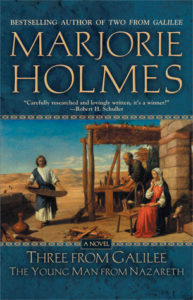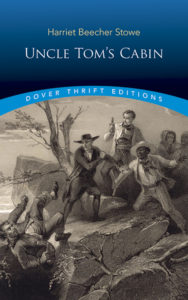Remember Ben Hur: A Tale of the Christ (1880), by Lew Wallace, and Judah Ben-Hur’s nail-biting chariot race? We saw it portrayed on the screen in 1959 (and on Netflix since) by the fit and ruggedly handsome Charlton Heston.
Or the quest of Roman tribune Marcellus, who during the crucifixion of Jesus bartered for Jesus’ robe, then spent the remainder of his life discovering and embracing who Jesus really was, in The Robe (1942), by Lloyd C. Douglass.
As a child I read (and still have on my bookshelf) The Prince of the House of David (1858), by J. H. Ingraham, a book of letters written from the perspective of a Hebrew daughter visiting Jerusalem to her father about her journey to know the Galilean—the Messiah—who changed her life. I remember feeling a strong kinship with this young woman, and wishing—longing—to have been there, to have seen what she saw.
 As a teen I read Two From Galilee, Three From Galilee, and The Messiah (1972), a trilogy by Marjorie Holmes, and yearned to visit the Holy Land—which I finally did, in 1982.
As a teen I read Two From Galilee, Three From Galilee, and The Messiah (1972), a trilogy by Marjorie Holmes, and yearned to visit the Holy Land—which I finally did, in 1982.
Then there are wholesome novels whose characters show us young people growing to adulthood, guided by love, family, sacrifice, and general Christian principles, like Louisa May Alcott’s Little Women (1868 and 1869), and Lucy Maud Montgomery’s Anne of Green Gables series (1908–1939).
There are novels that clearly show characters coming to repentance and belief—like the novels girls read for decades by beloved author Grace Livingston Hill (1877–1949).
Even before that, Martha Finley—whose repurposed home still stands in Elkton, Maryland, wrote the Elsie Dinsmore series (1867–1905), popular in my grandmother’s day. My sister and I discovered those books in our grandmother’s attic trunk and devoured them, secretly glad we didn’t live under such rigid rules.
In one of L. M. Montgomery’s Emily books, the protagonist is told to “go and read the Elsie books”—as if that will help her find the “straight and narrow.”
More recently, Lois Gladys Leppard penned the Mandie series of novels (1983–2004) for girls. My own daughter, as a child, read and imagined herself the heroine of each one.
 And then there are books whose characters slap the hypocrisies of traditional religion in the face—only to come with fortitude to faith and mercy by embracing the social justice espoused in the Bible. Think of the imagery, the parables and lessons found in A Christmas Carol, by Charles Dickens (1843); The Adventures of Huckleberry Finn, by Mark Twain (1884 and 1885); and Harriet Beecher Stowe’s Uncle Tom’s Cabin (first published in book form in 1852).
And then there are books whose characters slap the hypocrisies of traditional religion in the face—only to come with fortitude to faith and mercy by embracing the social justice espoused in the Bible. Think of the imagery, the parables and lessons found in A Christmas Carol, by Charles Dickens (1843); The Adventures of Huckleberry Finn, by Mark Twain (1884 and 1885); and Harriet Beecher Stowe’s Uncle Tom’s Cabin (first published in book form in 1852).
Such books—longtime classics—were purposefully conceived and written. In March of 1850, Stowe wrote in a letter to the editor of an antislavery journal that she planned to pen a story about the problem of slavery: “I feel now that the time has come when even a woman or a child who can speak a word for freedom and humanity is bound to speak…. I hope every woman who can write will not be silent.”
I have a magnet, purchased at the Stowe Museum, that quotes her: “I wrote what I did because as a woman, as a mother, I was oppressed and broken-hearted with the sorrows and injustice I saw, because as a Christian I felt the dishonor to Christianity—because as a lover of my country, I trembled at the coming day of wrath.”
All in all, we’re reminded that writers write books of purpose and readers read books of purpose because we want to be drawn to higher, God-glorifying ground, to walk steadily toward the raised and radical bar Jesus held for us.
We know where to find that inspiration, that standard of justice, that high bar of love and mercy, that wisdom of the ages and the peace that surpasses all understanding.
For the best we go to the source, the Holy Bible. All the wonderful novels—classics from the past and novels penned with purpose today—are but faint echoes of the Book of Books.
But the wonderful, life-changing, life-challenging stories our grandparents and parents—and we—have read, have made us part of who we are, have strengthened our characters and faith. They’ve become helps and companions on our life’s journey.
What greater gift can we give than to share the books that have helped and changed us with those we love—give them to our family, our friends, and when the opportunity strikes, bring them to the attention of readers everywhere? We possess a strong legacy and a springboard toward faith for a new generation.
If not us, then who?
RELATED LINK: Historical Q&A: Cathy Gohlke (Until We Find Home)
Visit Cathy Gohlke’s author page at https://www.familyfiction.com/authors/cathy-gohlke
Click to Read More.


